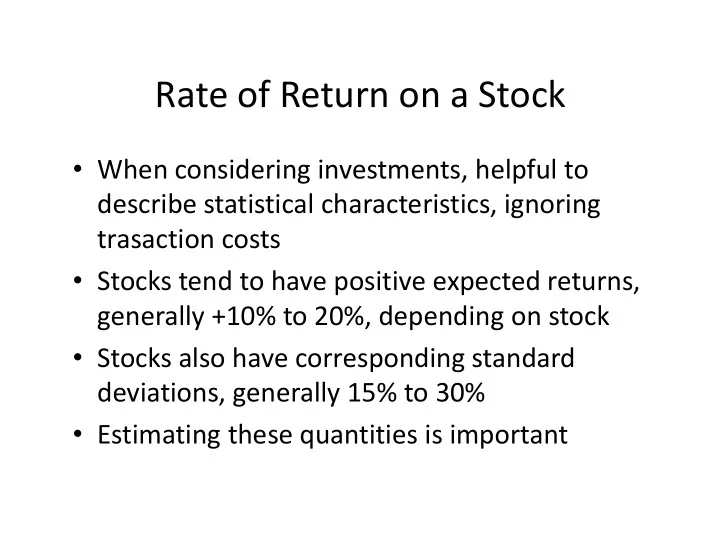

Rate of Return on a Stock � When considering investments, helpful to describe statistical characteristics, ignoring trasaction costs � Stocks tend to have positive expected returns, � Stocks tend to have positive expected returns, generally +10% to 20%, depending on stock � Stocks also have corresponding standard deviations, generally 15% to 30% � Estimating these quantities is important
Example Example: Let’s examine the characteristics of Yahoo (YHOO) and Disney (DIS) between 9/30/09 and 10/26/09 Average Sample Return Sample Standard Deviation of the Returns Covariance, Correlation
Portfolio Mean and Variance Suppose we have n assets with random rates of � � � � ����� � return � � These rates of return have expected values = = = = = = � � � � � � � � � � � � � � � � � � � � � � � � � � � � ���� ���� � � � � � � � � � � � � � � � � If we form a portfolio of these assets with weights w i , i = 1,2, …, n. The rate of return of the portfolio is = + + + � � � � � ��� � � � � � � � �
Mean Return of a Portfolio If we take the expected value of both sides = + + + � � � � � � � � � � � � � � ��� � � � � � � � � � � � Expected rate of return of a portfolio is the Expected rate of return of a portfolio is the weighted sum of the expected rates of the return of the individual assets from which the portfolio is composed
Variance of Portfolio Return Let σ 2 be the variance of the portfolio return and the covariance of the return of asset i with asset j by σ ij The variance of a portfolio’s mean can be The variance of a portfolio’s mean can be calculated from the covariances of the pairs of asset returns and the asset weights � ∑ σ = − = σ � � � �� � � � � � � � � �� = � � � �
Two Asset Portfolio Example We have two assets with covariance .01 = σ = � � �� � � � �� Asset 1: � � = σ = � � �� � � � �� Asset 2: � � Calculate the mean, variance, and standard deviation of a portfolio with weights w 1 =.25 and w 2 =.75
Diversification � A portfolio with very few assets may be risky, as measured by variance � Variance of a portfolio can be reduced by adding more assets adding more assets � The way portfolio variance is measured implies that assets with low covariance to each other can help lower overall variance � Extreme case: all assets uncorrelated
Portfolio of Uncorrelated Assets Suppose we have n assets, equally weighted, uncorrelated, with mean m and variance σ 2 Return of the portfolio is � � � � � � � � � � ∑ = + + = � � � ��� � � � � � � � = � � The expected value of this is m and is independent of n
Variance of a Portfolio Variance of the portfolio is σ � � ∑ = σ = � ��� � � � � � � � = � � When assets are uncorrelated, portfolio When assets are uncorrelated, portfolio variance can be made arbitrarily small When assets are correlated there may be a limit to how much variance can be lowered
Variance of Correlated Assets Assume each asset has rate of return with mean m and variance σ 2 , and each return pair has covariance .3σ 2 for i ≠ j The variance of the such a portfolio is The variance of the such a portfolio is σ � � � � � ∑ = − = + σ � � ��� � � � � � � � � �� � � � � � = � �
Recommend
More recommend